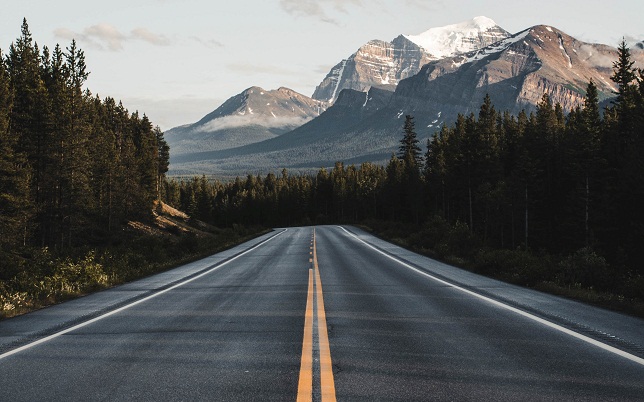Muslim rulers of India gave innumerable roads and highways to India and it is not possible to give a detailed account of each of them here in this post. Therefore we are mentioning only the main and reputed thoroughfares of the Muslim period.
The highway connecting the famous city of Sehwan (earlier Siwistan) in Sindh to Delhi passed through Multan covering a distance of 10 days journey from Siwistan to Multan while it took fifty days to reach Delhi from Siwistan by this road.
The second main road connecting Delhi to Daulatabad, could be covered in forty days. On either side of the whole length of this road willow and other trees with pliant branches were planted in a way that the traveller always found himself walking through a garden.
On every mile the road had three caravanserais where the travellers could purchase necessary provisions required during the journey. The highway thus presented a pleasant picture of a pathway and bazaars all the way from Delhi to Daulatabad.
The highway from Tilangana to Malabar was provided with a caravanserai and royal guest house at every stop-over of a day’s journey with the result that the travellers did not have to carry any provisions for the journey.
The fourth main thoroughfare ran from Delhi to Dhar in Malwa in Madhya Pradesh. This road could be covered in 24 days and had pillars at every mile indicating the distance from the two ends of it.
All these roads were once the arterial highways always full of travellers. The famous traveller of Morocco, Muhammad ibn Batutah, had seen and traversed these roads as mentioned by him in his memoirs.
Incredible Work by Muslim Ruler Sher Shah Suri
Sher Shah Suri constructed a number of roads after ascending the throne. They included one of the longest highways in the country. Starting from Bal Nath Jogi near the fort of Rohtasgarh which is 193 kilometers to the west of Lahore, this road went to Sonargaon in Bengal and could be covered in four months during those days (This road is now known as Grand Trunk Road).
Of the other roads built by Sher Shah Suri one ran from Agra to Jodhpur and Chitor and two others from Lahore to Multan and from Agra to Mandu.
On either side of all these roads were planted fruit trees. 1700 caravanserais were erected on these roads with separate lodgings for Muslims and Hindus. Each caravanserai had a stall for providing cool drinking water to the travellers and also warm water for taking bath, if one desired.
The travellers were supplied with food and beddings, as well as fodder for their animals, free of cost, so that nobody had to bother about the outfit for undertaking the journey on these roads.
Each caravanserai contained a well and a mosque with a Mu’azzin (caller for prayer) and an Imam (one who leads the congregational prayers) in attendance. A contingent of the army along with a Kotwal () and other police officials kept the peace in each caravanserai.
Further Work by Islam Shah
When Islam Shah (also known as Salim Shah) ascended the throne after the death of his father Sher Shah Suri, he doubled the number of caravanserais on these roads, constructed new mosques and wells of burnt brick, appointed servants for supplying water and other provisions to the travellers and stabled post-horses in the new caravanserais for the conveyance of the royal mail.
Work by Akbar
Akbar too, paid attention to the upkeep of roads. In 1574 he erected a well and a minaret at every mile on Agra- Ajmer road.
Huge Work by Muslim Ruler Jahangir
Jahangir was still more careful about the construction and maintenance of the roads. He ordered the following constructions in 1619:
- Shade trees should be planted on either side of the road connecting Lahore to Agra,
- Minarets should be erected on every mile,
- A well on every third mile
- A caravanserai with a mosque and well on every fifth mile.
Jahangir also got the Lahore-Kashmir road constructed in 1622 on which 11 palaces were constructed on the stop-over of a day’s journey. Jahangir also constructed the road from Bengal to Attock which passed through Agra. The road had shade-trees planted on either side. (Athar-us-Sanadid, p. 262).
It might be mentioned here that four tracks lead to the valley of Kashmir. The first is the pathway via Pakhli, 241 Km. in length, with 35 stop-overs.
The second one passes through Chaumukha, has 29 halts and is 164 Km. long.
The third one, which goes through Pinanj has 23 stopping places and covers a distance of 159 kms.
The fourth track enters the valley through Pir PanjaI. It is the shortest route covering only 129 Kms. and has 8 halts in the plains and 12 in the hilly tracts. Jahangir got the fourth track converted into a regular road with caravanserais on it.
Work by Muslim Ruler Shahjahan
Shahjahan also showed keen interest in the construction of roads. The road built by All Mardan Khan, Governor of Kashmir, from the vale of Kashmir to Rajouri dates from the reign of Shahjahan.
The ruins of wells, springs and caravanserais by the side of this road can still be seen at Tahna, Bahram, Gila, Sokhtah, Poshianab, Shachamarg and Hirapur.
Works by Muslim Emperor Aurangzeb
Aurangzeb Alamgir appointed an officer in 1661, for undertaking the repairs of Lahore-Kashmir road, Agra- Aurangabad Road and Lahore-Kabul Road.
The officer was also charged with the responsibility of getting the old caravanserais on these roads repaired and constructing new ones of burnt brick with mosques, wells and shops, and making adequate arrangements for the safety of travellers. Large amounts were spent by Aurangzeb on the construction of bridges over rivers and canals crossed by these roads.
Postal Services
During the Muslim period two methods were employed for conveyance of the royal mail. One of these was known as awlaq after the Turkish word meaning the royal horses; under which riders carrying the royal mail delivered the mail to the riders of post-horses at the next station at a distance of four miles.
The other method employed was to send the mail through runners. A mile consisting of 5,000 cubits length, was divided into three parts.
At each point, preferably outside the nearest village, a small building with three small cupolas was erected where the post-men always remained on the lookout for the incoming mail.
These men carried a small stick of one yard on the one end of which a pair of brass cymbals was fixed. As soon as the mail-bag arrived from the previous station, the runner on duty took the bag in his right hand or carried it on his back in case it was heavier, and ran up to the next station with the ringing cymbals attached to the stick in his left hand.
The royal mail thus conveyed from one station to another was carried to its destination faster than the post-horses. Ibn Batutah has also made a mention of this method in his memoirs.
The mailmen were required to cover a mile in an hour and thus they could convey the mail from Ahmadabad to Delhi in 12 days. If the mail was urgent, it was delivered in a week. Any delay by the runners in conveyance of the mail was punishable by fine up to one-fourth of a month’s salary.

